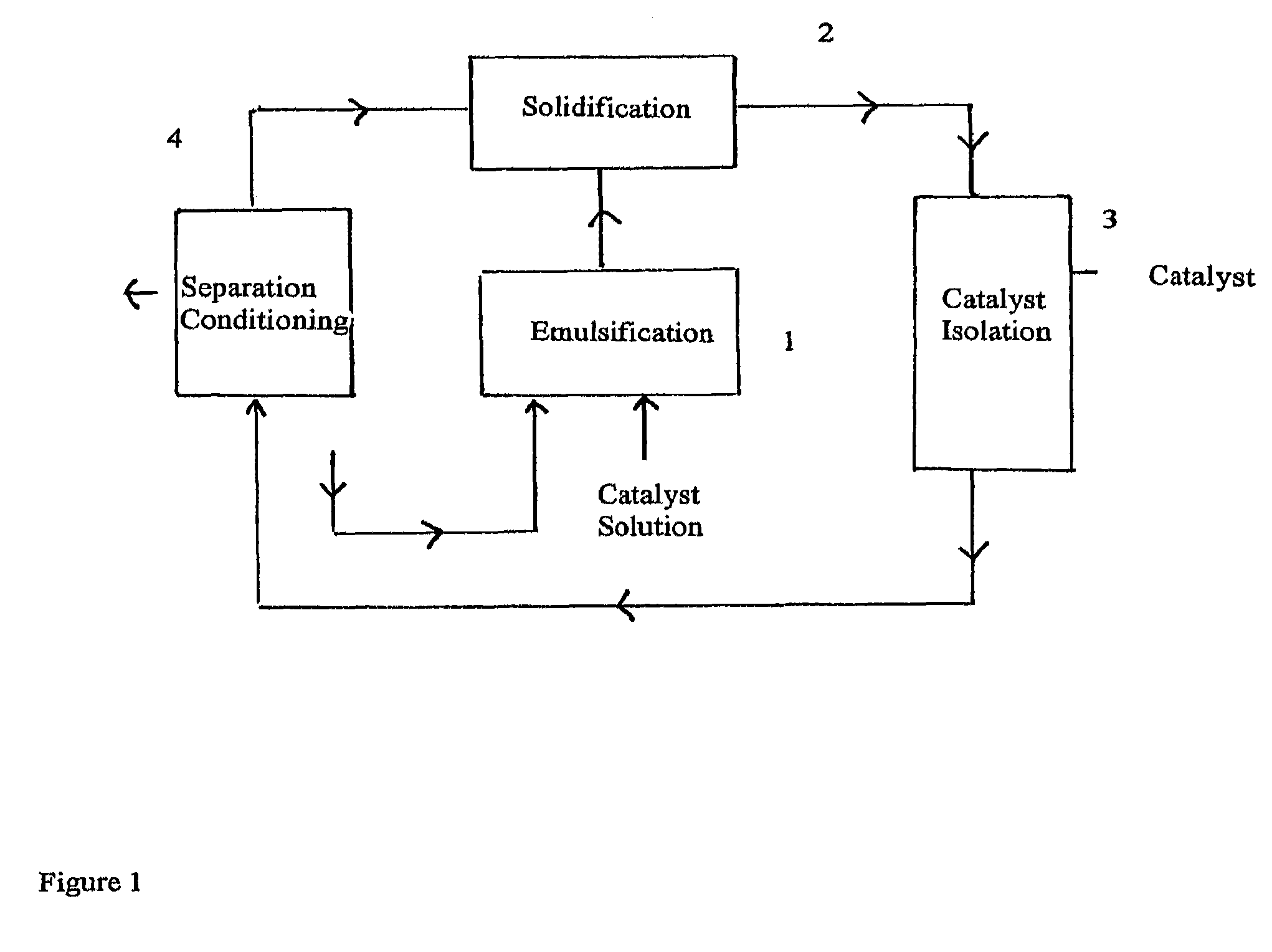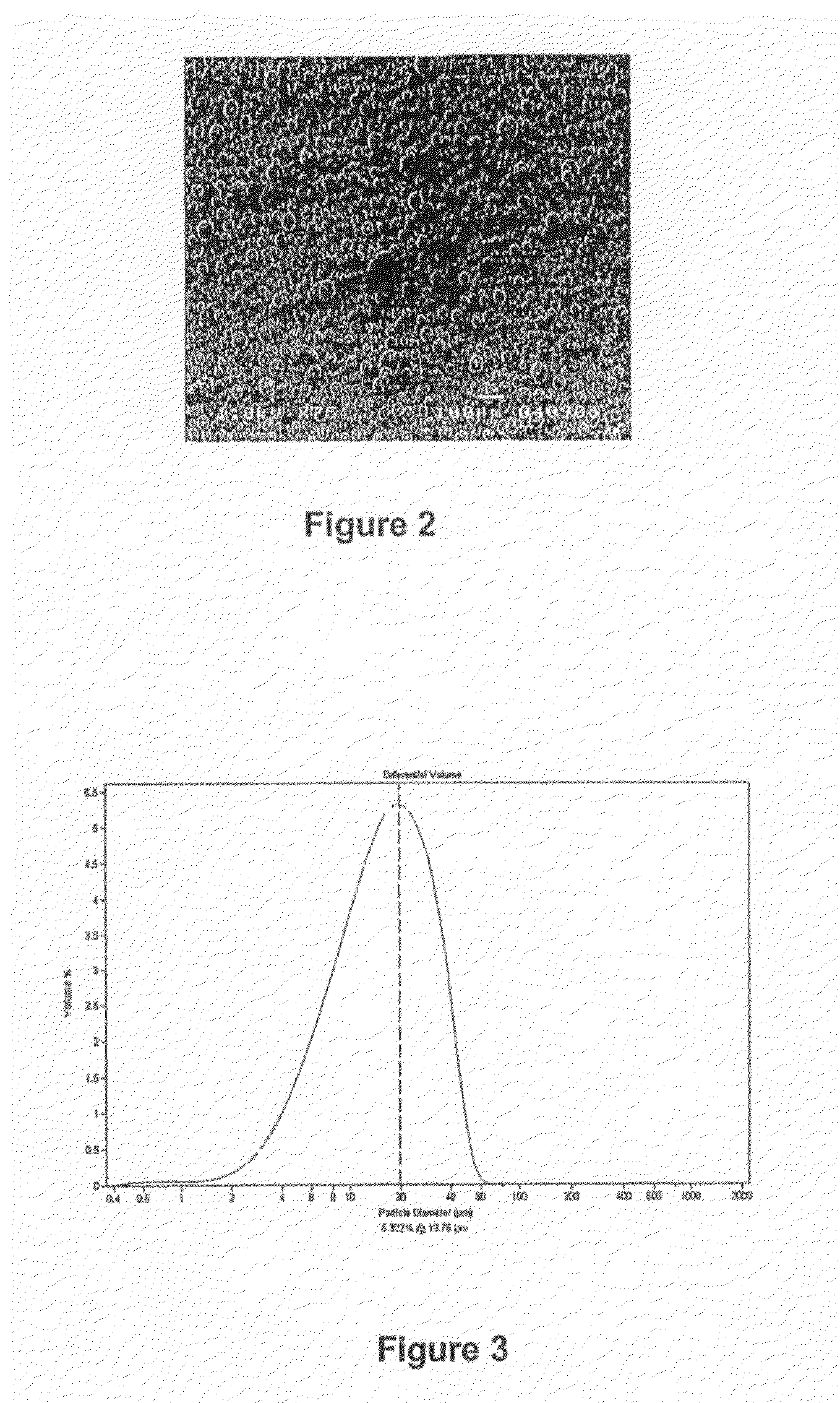Process for the preparation of an olefin polymerisation catalyst
a polymerisation catalyst and polymer technology, applied in the field of olefin polymerisation catalyst preparation, can solve the problems of inhomogeneity of the resulting catalyst, catalyst support on external carriers has its drawbacks, and the polymer properties are not easily available, so as to achieve easy and economical operation, without any loss in catalyst quality and amoun
- Summary
- Abstract
- Description
- Claims
- Application Information
AI Technical Summary
Benefits of technology
Problems solved by technology
Method used
Image
Examples
example 1
[0115]Complex Preparation
[0116]264 mg of rac-dimethylsilanediyl-bis(2-methyl-4-phenylindenyl)zirconium dichloride (97 wt.-%, purchased from Catalytica Advanced Technologies) were reacted with 20 ml MAO solution, 30 wt.-% in toluene (purchased from Albemarle) under stirring at room temperature in a septa bottle for 30 minutes. A red solution of activated complex (with target Al / Zr=200) was obtained (solution 1).
[0117]Surfactant Preparation
[0118]0.5 ml of 1H,1H,7H-perfluoroheptan-1-ol (Apollo Scientific, UK) were added slowly to 2.5 ml MAO under stirring. A vigorous reaction with liberation of gas occurred. After 15 minutes, an additional 2.5 ml of MAO were added to the solution. No visible reaction was observed while stirring for additional 15 minutes. The resulting surfactant solution was transferred into the septa bottle with solution 1.
[0119]Continuous Operation
[0120]Emulsification
[0121]As emulsion reactor, a continuous stirred tank reactor (volume approx. 400 ml) made of glass an...
example 2
[0140]The complex and surfactant were prepared as in example 1.
[0141]Continuous Operation
[0142]The process of example 1 was repeated with the exception that some minor changes in temperature were done.
[0143]Emulsification
[0144]The same reactor as in example 1 was used. The temperature in the reactor was adjusted to approx. +4° C. via a cryostat connected to the reactor's cooling jacket.
[0145]The reactor was (partly) filled by pumping cold perfluorooctane from the PFO storage tank.
[0146]Under stirring, the complex / MAO solution mentioned above was added batch-wise to the reactor via a syringe. Emulsification of the two immiscible phases (complex / MAO / toluene and PFO) was done by the rotor-stator mixer operated at 4500 RPM leading to a tip speed of about 4.7 m / s.
[0147]Solidification
[0148]The resulting emulsion was continuously pressed out from the emulsion reactor to a solidification tube via a dip tube by pumping in additional cold PFO from the PFO tank with the pump (flow rate used wa...
example 3
[0164]The complex and surfactant were prepared as in example 1.
[0165]Continuous Operation
[0166]Emulsification
[0167]As emulsion reactor, a continuous working chamber for the rotor stator stirrer (volume approx. 70 ml) made of steel and equipped with a cooling coil attached to chamber wall was used. The reactor was cooled to −10° C. in the cooling coil.
[0168]The reactor was filled by pumping in cold perfluorooctane from a PFO storage tank and complex / MAO solution pumped in continuously from a septa bottle by an additional metering pump.
[0169]Emulsification of the two immiscible phases (complex / MAO / toluene and PFO) was done by the rotor-stator mixer operated at 4000 RPM leading to a tip speed of about 4.17 m / s.
[0170]The emulsification chamber was operated fully filled.
[0171]Solidification
[0172]The emulsion prepared above was continuously pressed out from the reactor to a solidification tube via a dip tube (Teflon, inner diameter 3 mm) and continuously pumping in cold PFO and complex / MA...
PUM
| Property | Measurement | Unit |
|---|---|---|
| temperature | aaaaa | aaaaa |
| temperature | aaaaa | aaaaa |
| temperature | aaaaa | aaaaa |
Abstract
Description
Claims
Application Information
 Login to View More
Login to View More - R&D
- Intellectual Property
- Life Sciences
- Materials
- Tech Scout
- Unparalleled Data Quality
- Higher Quality Content
- 60% Fewer Hallucinations
Browse by: Latest US Patents, China's latest patents, Technical Efficacy Thesaurus, Application Domain, Technology Topic, Popular Technical Reports.
© 2025 PatSnap. All rights reserved.Legal|Privacy policy|Modern Slavery Act Transparency Statement|Sitemap|About US| Contact US: help@patsnap.com



